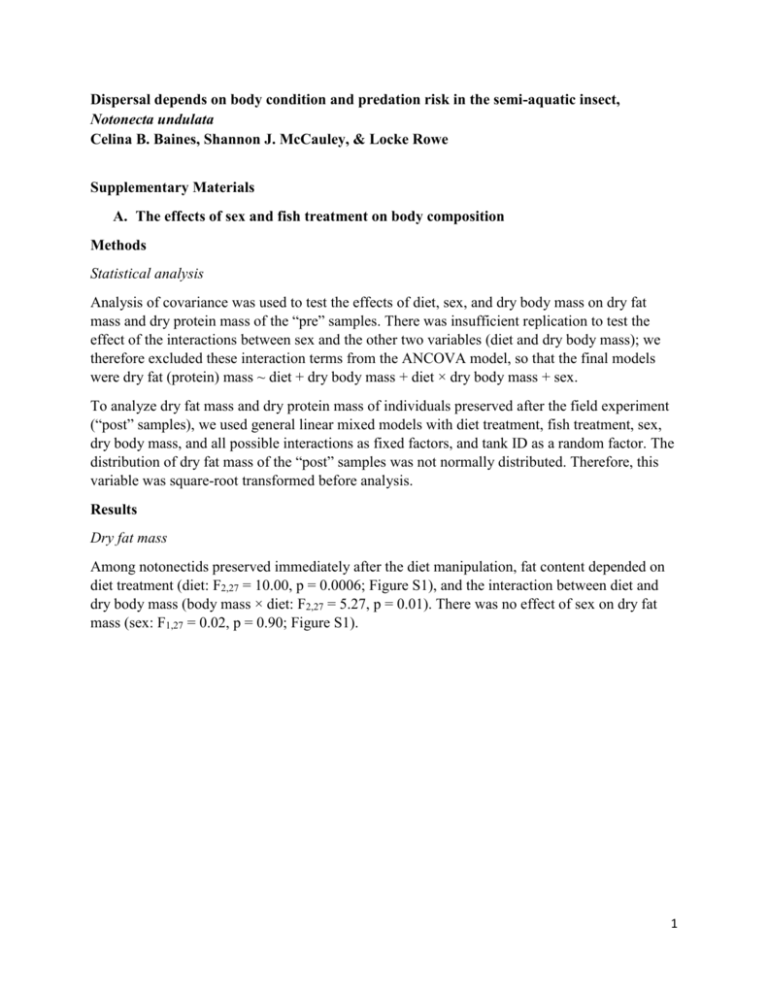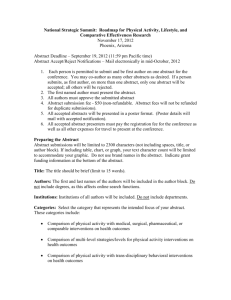
Dispersal depends on body condition and predation risk in the semi-aquatic insect,
Notonecta undulata
Celina B. Baines, Shannon J. McCauley, & Locke Rowe
Supplementary Materials
A. The effects of sex and fish treatment on body composition
Methods
Statistical analysis
Analysis of covariance was used to test the effects of diet, sex, and dry body mass on dry fat
mass and dry protein mass of the “pre” samples. There was insufficient replication to test the
effect of the interactions between sex and the other two variables (diet and dry body mass); we
therefore excluded these interaction terms from the ANCOVA model, so that the final models
were dry fat (protein) mass ~ diet + dry body mass + diet × dry body mass + sex.
To analyze dry fat mass and dry protein mass of individuals preserved after the field experiment
(“post” samples), we used general linear mixed models with diet treatment, fish treatment, sex,
dry body mass, and all possible interactions as fixed factors, and tank ID as a random factor. The
distribution of dry fat mass of the “post” samples was not normally distributed. Therefore, this
variable was square-root transformed before analysis.
Results
Dry fat mass
Among notonectids preserved immediately after the diet manipulation, fat content depended on
diet treatment (diet: F2,27 = 10.00, p = 0.0006; Figure S1), and the interaction between diet and
dry body mass (body mass × diet: F2,27 = 5.27, p = 0.01). There was no effect of sex on dry fat
mass (sex: F1,27 = 0.02, p = 0.90; Figure S1).
1
Figure S1. Dry fat mass vs dry body mass +/- 95% confidence of fit bands for males and females
in all diet treatments among individuals preserved immediately after the diet manipulation
(“pre”; n = 34).
2
Among notonectids preserved after the field experiment, dry fat mass was strongly correlated
with dry body mass (Figure S2, Table S1). Females had slightly greater dry fat mass than males
with the same dry body mass (Figure S2, Table S1). Neither diet treatment nor fish treatment had
a significant effect on dry fat mass (Table S1).
Figure S2. Dry fat mass vs dry body mass +/- 95% confidence of fit bands for males and females
in all diet treatments and both fish treatments. These individuals were preserved after the field
experiment (“post”; n = 119).
3
Table S1. Results of GLMM modeling the effects of diet treatment, fish treatment, sex, dry body
mass, and all possible interactions on the square root of dry fat mass of the “post” samples.
* indicates significance at α = 0.05.
Source
Dry body mass
Sex
Dry body mass : Sex
Diet
Dry body mass : Diet
Sex : Diet
Dry body mass : Sex: Diet
Fish
Dry body mass : Fish
Sex : Fish
Dry body mass : Sex: Fish
Diet : Fish
Dry body mass : Diet : Fish
Sex : Diet : Fish
Dry body mass : Sex : Diet : Fish
DFNum
1
1
1
2
2
2
2
1
1
1
1
2
2
2
2
DFDen
93.34
93.70
92.77
91.81
92.34
91.86
92.64
43.67
93.34
93.70
92.77
91.81
92.34
91.86
92.64
F
13.35
4.05
0.57
0.54
0.42
0.77
1.11
0.01
0.89
0.01
0.24
0.10
0.09
0.52
0.16
P
0.0004*
0.0470*
0.4503
0.5818
0.6576
0.4681
0.3355
0.9204
0.3480
0.9156
0.6268
0.9057
0.9181
0.5953
0.8532
4
Dry protein mass
Among notonectids preserved immediately after the diet manipulation, protein content did not
depend on body mass, diet treatment, or the interaction between diet and dry body mass (body
mass: F1,28 = 1.33, p = 0.26; diet: F2,28 = 0.35, p = 0.71; body mass × diet: F2,28 = 0.98, p = 0.39;
Figure S3). There was no effect of sex on dry protein mass (sex: F1,28 = 1.06, p = 0.31; Figure
S3).
Figure S3. Dry protein mass vs dry body mass +/- 95% confidence of fit bands for males and
females in all diet treatments among individuals preserved immediately after the diet
manipulation (“pre”; n = 35).
5
Among notonectids preserved after the field experiment, there was a significant interaction
between dry body mass and fish treatment on dry protein mass (Figure S4, Table S2); there was a
steeper positive slope of dry protein mass on dry body mass in fish tanks than in fishless tanks.
There was also a significant interaction between dry body mass and sex (Figure S4, Table S2);
the slope of dry protein mass on dry body mass was slightly more positive in males than in
females.
Figure S4. Dry protein mass vs dry body mass +/- 95% confidence of fit bands for males and
females in all diet treatments and both fish treatments. These individuals were preserved after the
field experiment (“post”; n = 119).
6
Table S2. Results of GLMM modeling the effects of diet treatment, fish treatment, sex, dry body
mass, and all possible interactions on dry protein mass of the “post” samples. * indicates
significance at α = 0.05.
Source
Dry body mass
Sex
Dry body mass: Sex
Diet
Dry body mass : Diet
Sex : Diet
Dry body mass : Sex : Diet
Fish
Dry body mass : Fish
Sex : Fish
Dry body mass : Sex : Fish
Diet : Fish
Dry body mass : Diet : Fish
Sex : Diet : Fish
Dry body mass : Sex : Diet : Fish
DFNum
1
1
1
2
2
2
2
1
1
1
1
2
2
2
2
DFDen
91.61
91.47
90.89
91.70
92.41
92.76
92.13
28.22
91.61
91.47
90.89
91.70
92.41
92.76
92.13
F
0.18
0.06
4.62
0.29
0.19
1.51
0.57
1.64
8.74
3.09
0.52
0.38
1.95
0.57
0.14
P
0.6709
0.8079
0.0343*
0.7502
0.8270
0.2258
0.5692
0.2108
0.0040*
0.0821
0.4711
0.6830
0.1476
0.5685
0.8687
B. The effect of sex on mass gain during the field experiment
Methods
We tested the effect of sex on fat and protein mass gain during the field experiment using
ANCOVA. The response variable was dry fat mass or dry protein mass, and the predictor
variables were type (i.e. timing of preservation – before or after the field experiment), dry body
mass, sex, and all possible interactions.
Results
Dry fat mass
Notonectids preserved after the field experiment had greater fat mass than those preserved
immediately after the diet manipulation (Figure S5, Table S3). There was no effect of sex on fat
mass gain (Figure S5, Table S3).
7
Figure S5. Dry fat mass vs dry body mass +/- 95% confidence of fit bands for males and females
preserved immediately after the diet manipulation (“pre”; n=34) and after the field experiment
(“post”; n=119).
Table S3. Results of ANCOVA modeling the effects of timing of preservation (type), dry body
mass, sex, and all possible interactions on dry fat mass. * indicates significance at α = 0.05.
Source
Type
Dry body mass
Type : Dry body mass
Sex
Type : Sex
Dry body mass : Sex
Type : Dry body mass : Sex
DF
1
1
1
1
1
1
1
F
16.96
79.49
9.31
0.07
1.13
0.55
1.07
P
<0.0001*
<0.0001*
0.0027*
0.7953
0.2886
0.4589
0.3023
8
Dry protein mass
Notonectids preserved after the field experiment had greater protein mass than those preserved
immediately after the diet manipulation (Figure S6, Table S4). There was no effect of sex on
protein mass gain (Figure S6, Table S4).
Figure S6. Dry protein mass vs dry body mass +/- 95% confidence of fit bands for males and
females preserved immediately after the diet manipulation (“pre”; n=35) and after the field
experiment (“post”; n=119).
9
Table S4. Results of ANCOVA modeling the effects of timing of preservation (type), dry body
mass, sex, and all possible interactions on dry protein mass. * indicates significance at α = 0.05.
Source
Type
Dry body mass
Type : Dry body mass
Sex
Type : Sex
Dry body mass : Sex
Type : Dry body mass : Sex
DF
1
1
1
1
1
1
1
F
42.16
4.05
0.60
0.57
1.16
0.05
0.08
P
<0.0001*
0.0461*
0.4406
0.4507
0.2836
0.8226
0.7790
C. The effect of sex on dispersal probability
Methods
We tested whether the sex ratio of the “pre” samples was different from the sex ratio of the
“post” samples using a χ2 contingency test.
Results
The sex ratio was strongly male-skewed in both “pre” and “post” samples (Figure S7). There was
no significant difference in the sex ratio of “pre” and “post” samples (χ21 = 0.9860, p = 0.3207).
100%
Percent
80%
60%
Male
40%
Female
20%
0%
pre
post
Timing of Preservation
Figure S7. The percent of all experimental animals of each sex in the “pre” (notonectids
preserved immediately after the diet manipulation (n = 34)) and “post” (notonectids preserved
after the field experiment (n = 119)) samples.
10
D. Initial and final probability of philopatry
A. Initial philopatry
B. Final philopatry
Figure S8. A) Mean proportion of philopatric individuals for each fish × diet treatment in
the first three days of the field experiment. B) Mean proportion of philopatric individuals
for each fish × diet treatment in the last three days of the experiment.
11









